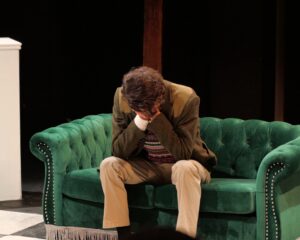For the weekend of Nov. 17 to 20, the School of Performing Arts put on Moliere’s “Tartuffe” at the Cyrus Pavilion Theatre.
The show itself follows a well-off family whose man of the house, Orgon, has become smitten with a pious beggar he took in, this being the titular Tartuffe. By the show’s start, Tartuffe has been taking advantage of Orgon’s kindness and makes himself at home in the estate. The rest of the family save for Orgon’s mother, Madame Pernelle, sees through the charade and conspire against Tartuffe.
The play, originally written and set in 17th-century France, has been moved to an American 1920s setting. As the audience entered the theater, they were met with decorations in the iconic art deco style of the time. The staging and costumes carried on this theme.
The play focuses on the theme of hypocrisy, with the so-called pious man being a fraud. Due to the nature of the material and time it was produced, the play was originally banned by the Catholic church. Since then, it has gone on to be considered a great piece of classical theater.
The set featured a large main room complete with a dining table and chairs that were moved around during the show. To the left and right were hallways leading backstage, allowing characters to lean in on conversations. There was also a large set of double doors on a raised platform, making for dramatic entrances. The set blended opulent whites and blues with art deco wallpapering. A bust of Tartuffe sat stage left. This was made by the 3D Printing Club. Scenery design was done by Daniel Bilodeau, a professor of speech and theatre at UMaine, with Emily Voight acting as props master. With Michelle Handley acting as costume designer and Alexis Foster, a lecturer in theatre at UMaine, as costume director, the costumes did well to transport the audience to the time period.
One of the more off-putting parts of the show is that it is written entirely in rhyme. At times, this makes the dialogue stiff. It becomes especially apparent during monologues, of which there are many. While the cast does well with this, using emotion and movement to make the lines seem more natural, there are moments where it feels like you’re watching Poetry Out Loud instead of a play.
Peter Bacon played the lead, Orgon, alongside fourth year Katie Brayson as his wife, Elmire and fourth year David Olski as Tartuffe. Bacon brought out the height of Orgon’s temperamental personality, playing up his emotions throughout the show.
Brayson and Olski performed a wonderful choreographed scene in which Tartuffe pursues Elmire. The two moved about the entire stage, with Brayson denying his affection as Olski followed after her.
Standing out in the show was Lydia Norris as the servant, Dorine. Her character was witty and brazen in nature. Norris added greatly to the comedy of the show, making motions behind characters’ backs to entertain the audience as well as adding charm and personality to the dialogue.
Even during the opening and right before intermission the cast took the time to set the stage and make things more fun. As the opening spiel was given, Tartuffe’s servant Laurent, played by Sam Mather, moseyed about the stage inspecting props and making off after knocking over items in the closet. Before the intermission, Laurent returned to steal some liquor from the cart, followed by Dorine cleaning up the set and setting it up for the next act.
The show ran for two hours, including a 15 minute intermission.










